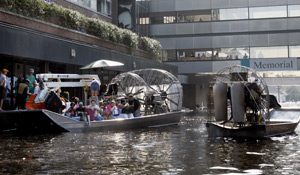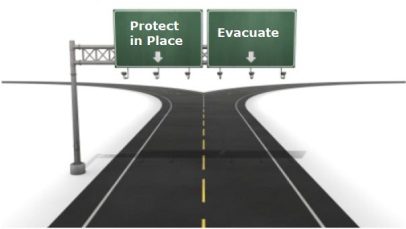Are your Parents and Loved Ones Safe?
Prologue: Over the years my articles in “Inside Homeland Security†have addressed significant gaps in the Nation’s Healthcare and Public Healthcare Sector (HPH). The sector remains the “weakest link in the Homeland Security chainâ€. It is important that those engaged in other sectors understand that the HPH remains unprepared to meet its expected roles and responsibilities in the country’s strategy for all-hazards preparedness and response. Previous articles and two books published in 2010 and 2011 cover in some detail the existing gaps in the Hospital industry. We have turned our attention to an even more neglected segment of the healthcare industry, Emergency Management for the most vulnerable among us, frail elderly and the physically/emotionally challenged of all ages.
We are not ready for the 2012 Hurricane Season

New Orleans Elderly Out in the Open
The new hurricane season is here; has the Non-Federal Healthcare and Public Health Sector learned anything from the “Killer Katrinaâ€? According to the Health and Human Services Office of Inspector General (HHS-OIG) Nursing Homes across the nation remain ill-prepared for the most likely hazard in their geographically bound regions. OIG reports released in August of 2006 and April of 2012 focused on the Gulf Coast Nursing Homes preparedness to deal with the region’s greatest natural hazard: “hurricanesâ€.
The final tally of known dead left in the wake of “Killer Katrina†in the New Orleans Metro Area is 971. A staggering number of the bodies, thirty-four percent (34%) were found in hospitals and nursing homes, a legacy which will long stand as one of the most egregious failures of the healthcare industry to protect the most vulnerable among us, frail elderly inpatients.
There are over 16,000 nursing homes across the nation. Seven years after one of the most destructive hurricanes in the country’s history, a reasonable mind would expect that those facilities which had up-close and personal experience with the horrors associated with such a traumatic event would be among the best prepared to deal with future threats.
Those who have followed the terrifying story of the thirty-five lives snuffed out at Saint Rita’s nursing home and repeated detailed accounts of the tragic loss of life during the protracted legal battle will never forget the pain and agony associated with that event.
There are others who would posit that they were the lucky ones, at least their deaths were swift and decisive. Other victims denied power to their life-support systems lingered for days as they slowly and painfully slipped into coma and death.
Despite a plethora of Katrina-inspired new laws, Homeland Security Presidential Directives (HSPDs) designed to “fill the gaps†identified in the After Action Reports (AARs), which focused on the wholesale failure of the Public Health and Healthcare system to protect its most vulnerable charges, the HHS-OIG reports that little had changed over the 7 years since Katrina. None of the 24 nursing homes selected for on-site inspection were prepared to either, “Protect in Place or Evacuate, their patientsâ€.
Despite high levels of self-reported “Complianceâ€, 100% of Audited Nursing Homes Failed
 Official compliance records from the group of nursing homes selected on-site inspection reflected compliance scores ranging from 92% to 94%. In all outward appearances the post-Katrina industry requirements were making these loci of care safe and secure from known natural disasters in the region.  Paper oversight at local, state and federal levels appeared to be working. Who would question the rigorous HHS-CMS contracted periodic external evaluations, the state office of survey and certification, patient advocacy system and the tireless Department of Homeland Security (DHS-FEMA) efforts to bring the (All-Hazards Readiness- later Community-Wide Resilience Actions) to all stakeholders at the Community level?
Official compliance records from the group of nursing homes selected on-site inspection reflected compliance scores ranging from 92% to 94%. In all outward appearances the post-Katrina industry requirements were making these loci of care safe and secure from known natural disasters in the region.  Paper oversight at local, state and federal levels appeared to be working. Who would question the rigorous HHS-CMS contracted periodic external evaluations, the state office of survey and certification, patient advocacy system and the tireless Department of Homeland Security (DHS-FEMA) efforts to bring the (All-Hazards Readiness- later Community-Wide Resilience Actions) to all stakeholders at the Community level?
The requirement for eligibility to receive federal reimbursement under any number of beneficiary groups underpinned compliance known as Conditions of Participation (COPs) a legal requirement.
The HHS-OIG reports were characterized by many in the nursing home industry as outdated and reforms had closed the gaps. Industry media supported the theme and public responses to the reports were surprisingly tepid.
Joplin Tornado Re-enforces OIG Findings of Unprepared Nursing Homes
The Joplin tornado surfaced the same set of concerns for the nursing home community. The After Action Reports revealed that local emergency planners had not integrated the sector into the incident management system,  (NIMS-ICS). As the industry spokesman described this failure “we have been treated like ‘Red-headed step children by the community emergency plannersâ€.
It is a tale “too often told†about “they did not reach out to us and local administrators did not want to get involvedâ€.
Located in “tornado alley†the area’s greatest geographically bound threat made little difference to those entrusted with the lives and limbs of their vulnerable charges.
 If there was any public notice that the “Derecho Season†starts in May and lasts through August with a peak period of late June to early July we missed it. Records reveal that these dangerous storms have a propensity to start in the mid-west and follow a route to the east coast. The latest such event took place in late June of this year. There are thousands of Long Term Care facilities in the path this latest storm. Many of these facilities lack robust design and construction and are vulnerable to wind and water damage. Additionally, they are ill prepared to deal with utility outages. Loss of electrical power and limited emergency power generation can take a deadly toll on these frail elderly patients many on life-support systems. Loss of adequate water supplies in 100 degree temperatures is a disaster waiting to happen. There is no reason to believe that these facilities are better prepared to protect their patients than those mentioned in the OIG reports and Joplin AAR.
If there was any public notice that the “Derecho Season†starts in May and lasts through August with a peak period of late June to early July we missed it. Records reveal that these dangerous storms have a propensity to start in the mid-west and follow a route to the east coast. The latest such event took place in late June of this year. There are thousands of Long Term Care facilities in the path this latest storm. Many of these facilities lack robust design and construction and are vulnerable to wind and water damage. Additionally, they are ill prepared to deal with utility outages. Loss of electrical power and limited emergency power generation can take a deadly toll on these frail elderly patients many on life-support systems. Loss of adequate water supplies in 100 degree temperatures is a disaster waiting to happen. There is no reason to believe that these facilities are better prepared to protect their patients than those mentioned in the OIG reports and Joplin AAR.
Cyber and Utility System Vulnerabilities
Deadly Cyber-attacks on area utility systems could place these populations in the same jeopardy.
Many anticipate massive cyber-attacks against the nation’s power grids which cascade to loss of area power needed by hospitals and nursing homes. Denial of air conditioning is only one of challenges when faced with extended power outages. More and more patients need life-support systems to survive. Perishable foods will spoil along with stocks of medicines needing climate control.
Just In Time Supply Chains Exacerbate the Challenges

Decision Number One
Maintaining supply chain connections to suppliers of critical items is problematic during emergencies, which isolates facilities and disrupts transportation. The current practice of “just in time†deliveries has its economic advantages but it also has its downside: Organizations have grown to depend on this “clockwork†delivery of items which spare them from building and maintaining burdensome storage capacity. Key to one of the most important decisions made by administrators in time of crisis is “do we have sufficient stocks to hold us through the anticipated crisis or should we evacuate. Either choice requires reliable-timely information. One lesson we have learned is that you can’t do it in the middle of a storm. You can’t change tires on a moving vehicle.
It is essential that everyone view ALL-Hazards preparedness as a journey and not a destination. Design, Construction and Retrofitting of healthcare facilities is the key to vulnerability reduction, (the mother of all mitigation). The reports from the west coast that the majority of non-federal hospitals have not been seismically upgraded to withstand a serious earthquake and some who have upgraded outer shells still have major vulnerabilities to inside utility systems should be a concern for those who enthusiastically label them the best places to receive care of this or that condition. Nursing Homes across the nation are far less robustly constructed than other healthcare facilities. Deaths attributed to the lack of preparedness in this sector fail to draw the attention that more dramatic events attract.
Nursing Homes Have Certain Unique Preparedness Requirements
Naturally occurring events, storms, landslides, wildfires disrupt critical utilities to nursing home and are responsible for the untimely deaths of elderly patient and if the numbers are large enough they get some press exposure. Many more succumb to treatment-acquired infections and assorted medical errors. Others, mostly patients on life-support systems are victims of an assortment of sporadic events which lead to power outages, accidental construction mishaps and assorted human factor failures.
Experts posit that the elderly prefer to stay in their home setting as they live out their golden years. The staggering growth in elder populations (10,000 a day into Medicare) combined with the rapid increase in disabled populations under 65, and increases in longevity call for increased capacity for care. (housing and acuity of patient care)
In the noble pursuit to accommodate this growing population there has been a huge emphasis in the areas of Access, Quality and Cost. Patient safety and security has morphed into a pure clinical domain.
Following the tragic deaths in New Orleans Saint Rita’s nursing homes during Katrina, the lawyers for the owners trooped in any number of witnesses to praise the level of care, access, quality and reasonable cost for the care provided by the owners. The one thing which was missing was a safe and secure locus of care.
The HHS-OIG report on gaps in the Nursing Home sector reaches only 16,000 of a total of 75,000 locations where the nation’s frail elderly and physical or mentally incapacitated of all ages are housed. The vast majority of these sites are less well prepared for all-hazards than the marginally prepared nursing homes in the surveys.
Â
The Standard Triple Threats and Violence are Major Concerns
The triple threats + 1 (violence): Evolving Infectious Diseases; More Frequent and Robust Natural Disasters and Looming Manmade Threats from a Host of those who wish to do us harm (Foreign and Domestic) + unabated violence within healthcare environments (off the streets, patients on caregivers, caregivers on patients and caregivers on caregivers) – female caregivers have become the most assaulted group in the Nation’s workplace, all challenge extant healthcare delivery efforts.
The same apathy and denial which plague all-hazards readiness within hospital industry pose even greater threats to the 75,000 care sites devoted to the elderly and physically/emotionally challenged populations.
History will judge a culture by the manner in which they provide for the most vulnerable among them, the young and old.






0 Comments